Nancy Moser's Blog, page 9
May 26, 2011
Will You Marry Me?
Noach immigrated to Minnesota from Sweden in 1869 at age 19. His sister and her husband were already living near Jordan, Minnesota. Noach worked in the area until he was 21, until he could homestead. A few years later, a group of these immigrants were together socially… and another Swenson (no relation), Muns Swenson and Eva, were at the gathering with a baby in a cradle. People teased Noach about not being married. He said, "I'll marry that one", meaning the baby in the cradle.
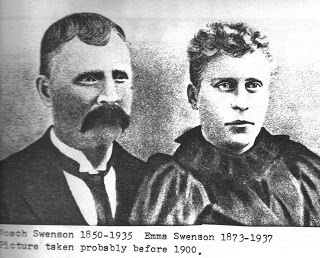
And he did. He married the baby, Emma, when she was 16, and he was 38. The community used to have barn dances. Emma loved to dance and Noach was attracted to the vivacious girl. But what did she see in him? There's no record of the whys behind it. Logically he married because he was attracted to her, maybe even loved her, and needed a wife to help him with his homestead. But Emma? A vivacious 16-year-old? Did she want to get away from home that badly? Did she love him? Did her parents approve and encourage her? Or were they against it? Whatever the motivation and emotions, the two were married in 1888, had six children, and were together until their deaths in the 1930's.
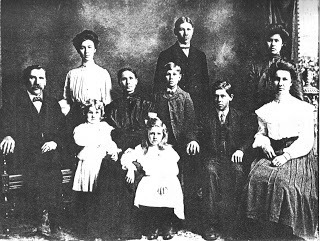 C.M. & Sarah and children
C.M. & Sarah and childrenMy grandmother, Ruth, is the youngest on the leftOn the other side of my family was C.M. Holmquist. He came over from Sweden about the same time as Noach (1869-ish). He was married to Sarah Christina Jonnsen in 1880 and they had nine children. My grandmother, Ruth, was the youngest, born in 1900. She was born eleven months after her brother Arthur died of polio, at age four. Birth and death must have been ever-present… There were nineteen years between child #1 and child #9. Sarah had to be exhausted. She always looked frail…
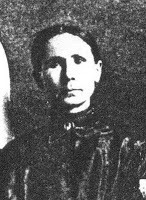
Sara Christine died in 1922 at age 67. Her daughter, Alma died a few months later of a sudden heart attack—at age 25.
Heartbroken, C.M. took a trip back to Sweden. On the trip he met Elvira Mattson. When he came home he presented her to his family. Surprise! Welcome my new wife! A ship-board romance? C.M. was seventy.
Logic might suggest that people were more pragmatic back then, that they knew life could be cut short at any time and so didn't waste time. Also, especially in rural communities, there were fewer prospects to choose from. Communication and transportation was limited beyond your community. The people you saw every day was who you got. Plus, there was the language and culture barrier. To find someone from the same background and roots probably took precedent over finding your true love or waiting for Mr. or Miss Right.
I'm sure many families have such odd pairings, either by age or circumstance. I'd love to hear some of your stories . . . //Nancy
May 22, 2011
1880 ... Omaha to Sacramento via train ... with Stephen Bly, author of Throw the Devil off the Train
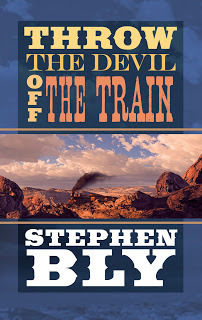
Today I'm honored to introduce you to a godly, humble man I admire greatly. The "official word" about Steve:
Stephen Bly is a Christy Award finalist and winner in the western category for The Long Trail Home, Picture Rock, The Outlaw's Twin Sister and Last of the Texas Camp. He has authored and co-authored with his wife, Janet, 105 books, both fiction and nonfiction. He and Janet have 3 married sons, 4 grandchildren, and 1 great-grandchild and live in the mountains of northern Idaho on the Nez Perce Indian Reservation.
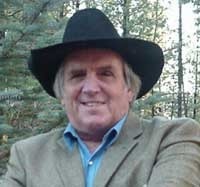 I first met Stephen and Janet Bly years ago at a writer's retreat. They were gracious and welcoming ... and they prayed faithfully for me when my husband, Bob, was in the midst of the cancer battle that took him to heaven back in 2001. Together, the Blys have modeled a lot of great things for me, not the least of which are faithfulness in prayer and commitment to each other and the Lord they love.
I first met Stephen and Janet Bly years ago at a writer's retreat. They were gracious and welcoming ... and they prayed faithfully for me when my husband, Bob, was in the midst of the cancer battle that took him to heaven back in 2001. Together, the Blys have modeled a lot of great things for me, not the least of which are faithfulness in prayer and commitment to each other and the Lord they love.The Sunday morning worship service when Steve pastored and served communion to the gathering of believing authors at that conference was unforgettable. I received a special grace note from the Father that long-ago Sunday morning ... a little preview of heaven. There will always be a special place in my heart for Janet and Stephen Bly, and I'm thrilled that Steve agreed to share some "footnotes from history" with us. (Stephanie G.)
_____________________________________________________________
What different sort of setting made you want to write this book?
You'd think after more than a hundred books in print, most of them set in the Old West, that I'd have exhausted every possible location. I've used cabins, saloons, dance halls, jails, hotels, cafes, sandbars and most any other place you could name. All, except one. In my last book, Creede of Old Montana, I set a whole scene inside an outhouse.
I've set stories in Colorado and Arizona, in New Mexico and Nevada, in Montana and Idaho, in Wyoming and Nebraska, in Texas and South Dakota. The old western Stagecoach was a road story in a stage.
But somehow the idea grew to get my characters on a train.
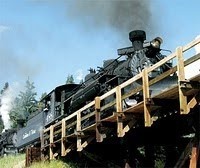 Throw The Devil Off The Train is a road story inside a train headed west. I wanted the grandeur of the West from a train window. . .the very slow journey, compared to modern transportation.
Throw The Devil Off The Train is a road story inside a train headed west. I wanted the grandeur of the West from a train window. . .the very slow journey, compared to modern transportation.
What was the most surprising thing you learned about "the real story" while researching this book?
I was most surprised that this story turned into more of a romance than a classic western. I knew there'd be western adventures such as a holdup, hijack, kidnapping and even a gold mine swindle. But when I shoved my two protagonists together on that long, cramped, chaotic train ride west, it was like throwing two cats into a burlap bag.
She's got to escape. She's desperate for a change. She hopes for a fresh start. She'd do anything to get to Philip, a childhood friend who runs a booming business in California. And she sure doesn't want anyone on the train to know her real last name. The long train ride promises a peaceful transition from one life to another.
He's into revenge. Race Hillyard heads west with a heart of vengeful justice, to settle a bitter score for his brother, and a body aching for sleep. Those who incited his brother's death should pay for their actions. He's on the prowl for the culprits, the one action at present that makes life worth living. He arrives at the train station exhausted and views the ride as a restful prelude before confrontations in California.
The only thing these two agree upon: they despise each other. Fiery, opinionated and quick to react, can they team up long enough to throw the devil off the train? That become the main question that moved my plot.
Did you need to know a lot about train food and other amenities?
I know a lot about what cowboys on the trail ate during that time. They filled up with biscuits, bacon, beans. And coffee. Ah, good old boiled coffee. The brand was probably Arbuckles which tasted like a Starbucks tall Americano with a quadruple shot. . . mixed with a bit of mud. By the late 1880s air-tights (canned food) appeared, such as peaches and tomatoes. That provided more ways for the camp cooks to make dessert. Sourdough bread thrived on long trail drives. But I didn't know much about dining on the rails.
As I began to research train food, I stopped when I realized my two main characters would not be have much in the way of funds. As it turned out a couple measly apples became a great point of contention and nourishment between them. So, this greatly simplified my research as they scavenged for plainer fair.
What one non-fiction book helped you research the most (for those who want to learn more)?
I used my Place Names books for the different stops along the route. They're great for historical tidbits such as real names and other interesting trivia of old towns. That, plus my memory of many other research journals and my University of Oklahoma and University of Nebraska nonfiction histories, as well as personal tours through the various trips we've taken along that trail ourselves, helped me with description. For instance, when passengers Catherine Goodwin and Race Hillyard take a walk along the muddy North Platte River, I know they'll see scattered buildings, mountains of firewood, bluffs, short, dry, brown grass sprawled for miles, as well as treeless, rolling prairie. I could even note possible wagon ruts that record the direction of an intrepid pioneer. The rest of the time was spent inside the train. I used lots of old photographs from various books and online for those details.
What spiritual encouragement did you draw from what you've learned?
As the theme developed for this story, I was reminded that all of us have flaws and strengths, but relationships can grow in spite of the weaknesses when we've got a commitment to the Lord to do things right.
Folks can gnaw on our nerves, but people are much more complex than we realize at first impression. We tend to judge and categorize humans before really knowing them. We thus eliminate friendships for surface reasons and lose out on some of God's special gifts to us.
Most of us hide spiritual and emotional hurts from others. . .and sometimes ourselves. We must be open to what God is doing around us, to receive the help he sends. This is what I've learned from the characters in my novels and especially from those in Throw The Devil Off The Train.
___________________________________________________
Throw The Devil Off The Train available May 2011. You can order through your local bookstore, your favorite online bookstore includingwww.Amazon.com or get autographed copies through the Blys website:http://BlyBooks.com/store.htm/
Visit the Blys at:
May 19, 2011
The Man on the White Horse
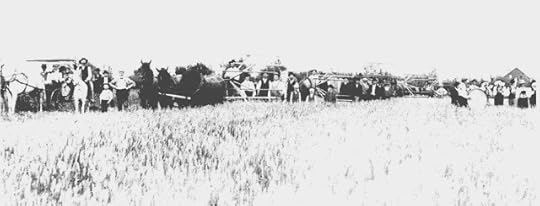 I recently helped my 90-year-old parents move into a retirement community. While going through a lifetime of possessions, we came upon an amazing photograph. I asked my mother "What's this?" She said, "The man on the white horse is your great grandfather, Noach Swenson. His wife, Emma is in the surrey." Looking closer at the picture I saw a band, playing in the field! Also, everyone was very dressed up. "What's the occasion?" Mom said Grandpa Noach had purchased five new binders and the community was celebrating.
I recently helped my 90-year-old parents move into a retirement community. While going through a lifetime of possessions, we came upon an amazing photograph. I asked my mother "What's this?" She said, "The man on the white horse is your great grandfather, Noach Swenson. His wife, Emma is in the surrey." Looking closer at the picture I saw a band, playing in the field! Also, everyone was very dressed up. "What's the occasion?" Mom said Grandpa Noach had purchased five new binders and the community was celebrating. 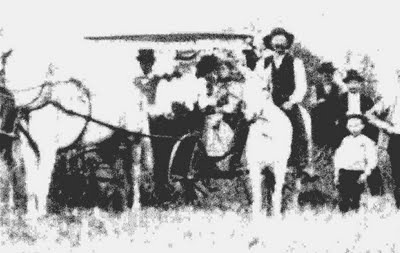 My great-grandparents: Emma in the surrey,
My great-grandparents: Emma in the surrey, and Noach Swenson on the white horse.
Amazing. Also amazing that they'd had the foresight to get a photographer to come out and take a picture of the day. It's probably in the 1890's… Actually, I found a newspaper article that said the man who sold Noach the binders, from the dealership in Canby, Minnesota, arranged for the band. Marketing, marketing…
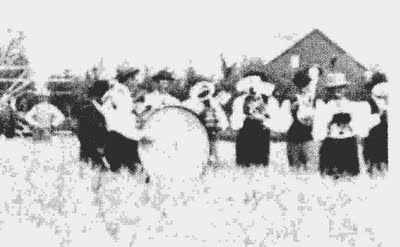 The band, out playing in the field As photographs often do, it made me delve into my family history a bit more. Luckily, my mother had done the genealogy of both sides of the family back in the 70's (before the Internet!) So I didn't have to look too far. I found out more about Noach and Emma. ..
The band, out playing in the field As photographs often do, it made me delve into my family history a bit more. Luckily, my mother had done the genealogy of both sides of the family back in the 70's (before the Internet!) So I didn't have to look too far. I found out more about Noach and Emma. ..He came to America in 1869, at the age of 19, the first of his family to leave Sweden for the "Land of Opportunity". As the ninth of eleven children, he would never inherit anything in Sweden. His ambition was to become an independent, land owning farmer, but he had to work a few years to earn enough money to realize his ambition. He worked on the railroad and as a farm hand until he went to Lac qui Parle County in Minnesota and filed for a homestead in 1879. He had to return to his farmhand job to earn more money, but he did order a house built on the homestead. When he returned he saw that it had no windows and no door! He had to whittle out an opening with his pocket knife! He fashioned a crude door but had no hinges, so cut a strip of leather off the top of each of his boots and fashioned leather hinges!
He and a neighbor pooled their resources and each furnished two oxen for a four-oxen team to break the sod. They each started working 20 acres. Staying warm in the house was a challenge in the Minnesota winters. Trees were scarce and couldn't be spared for fuel, so prairie grass was twisted into tight knots to slow its burning, and then put away for winter use. For the rest of his life, Noach planted many trees… when a grove died in the 1930's, he was very sad. Trees were special to him.
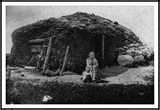 Sod house in Lac qui Parle County
Sod house in Lac qui Parle CountyHe knew the family of Mons Swenson (no relation). Mons had operated a ferry across the Minnesota River near the present town of Jordan (at that time Belle Plaine was the nearest town to the ferry.) Mons and his wife, Eva had a daughter, Emma—who was born in a log house at the ferry site in 1873. They moved to Noach's area and lived in a sod house until theirs could be built. One winter the snow covered the house and they had to shovel their way out, tying a rope between the front door and the barn in order so they wouldn't get lost in the blizzard.
Noach, age 38, decided he wanted to marry the lively Emma—age 16! And so they married in 1889. "Though he was a serious, reserved man who did not join much in gayety, he admired the pretty girl with the rosy cheeks and curly hair who twirled so gaily to the notes of her father's fiddle." He built a two-story house for her on the land adjoining his original farmstead. Twenty-two years age difference? Yikes.
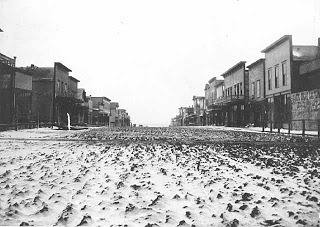 Nearby Dawson, MN 1892
Nearby Dawson, MN 1892They had seven children (one died young), and Emma was busy. During harvest, more so. She would have to cook three meals a day, and two lunches for the 20 farm hands. She had to take the lunches into the fields, but they came in for meals. She filled a crock with pancakes before she called them to breakfast in order to keep up with their appetites. One time (because of rain and delays) she had to feed 20 farmhands for 28 days straight. Emma was worn out!
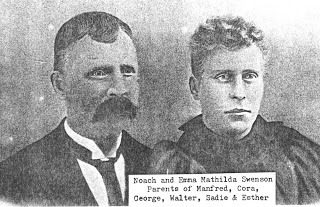 Once, newlywed Emma and her newly arrived sister-in-law from Sweden were washing clothes. They had a hot fire going on the stove. The chimney caught on fire. Emma told her SIL to ring the bell to call the men in, but got two buckets of water and climbed up on the roof and poured the water down the chimney herself. But it flamed up again and she realized they were going to lose the house. She went inside to save what she could. All she saved was her sewing machine. A pair of new shoes were on the treadle, but one fell off and the fire was too hot to save it. So Emma lost her house, with all her new wedding gifts and possessions inside. She saved a sewing machine and one new shoe. Later, the barn burned and 21 horses were lost. No insurance claims. No stores nearby to easily buy new things.
Once, newlywed Emma and her newly arrived sister-in-law from Sweden were washing clothes. They had a hot fire going on the stove. The chimney caught on fire. Emma told her SIL to ring the bell to call the men in, but got two buckets of water and climbed up on the roof and poured the water down the chimney herself. But it flamed up again and she realized they were going to lose the house. She went inside to save what she could. All she saved was her sewing machine. A pair of new shoes were on the treadle, but one fell off and the fire was too hot to save it. So Emma lost her house, with all her new wedding gifts and possessions inside. She saved a sewing machine and one new shoe. Later, the barn burned and 21 horses were lost. No insurance claims. No stores nearby to easily buy new things.Once Noach froze his feet going to get his cattle down by the river in a snowstorm. His toes were so badly frozen that they turned a dark blue after they thawed. He couldn't wear shoes, but had to wrap his feet in cloth until they healed.
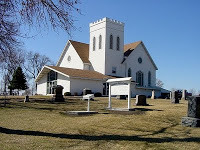 Providence Valley
Providence Valley Lutheran ChurchIn his later years, after he'd retired and moved to town, Noach still loved to ride out to the farm. He marveled at the gravel roads, for when he'd come to Minnesota, there were no roads. To find their way he said they'd get to the top of a ridge, look around, make a plan of action, and go to the next ridge, where they'd make a new plan. Sounds like a good philosophy of life in general… And perhaps that's how they got by, how they kept going amid all the hardships and challenges. They'd go to a high place and look for a new way to go… I know their faith grounded them and provided much comfort. They were founding members of the Providence Valley Lutheran Church--which is still a vibrant church.
Noach's farm prospered and was continued by my grandfather, George. My mother grew up on that farm, and only recently was it sold—over 100 years after it was started. Such were the hardships of homesteaders. Such was their tenacity and strength. It makes me wonder what I have to complain about in my easy life? Looking back, they inspire me. And they humble me.//Nancy
May 13, 2011
1887 Texas & Karen Witemeyer, Author of To Win Her Heart
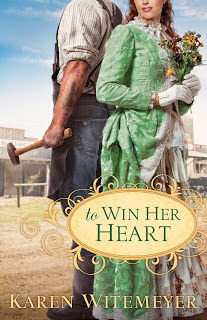
Well, I've just gotten home from spending the morning onGranny-duty (joy!), and what a wonderful surprise to find that my daughter's latest read just happened to be this book ... To Win Her Heart by fellow Bethany House author, Karen Witemeyer. Talk about Serendipity! Now, my daughter is what you would call a "discerning reader." She reads literally dozens of books a year and is a force to be reckoned with when it comes to our regular fiction book club meetings. The woman knows the world of Christian fiction ... and she gives this story of a blacksmith with a criminal past and a librarian with pacifist ideals a "thumbs up." It is my distinct pleasure and honor to introduce y'all to Karen Witemeyer as she shares some of her own "novel inspirations from history." Enjoy! ...............Stephanie G.
As a writer, nothing excites me more during the research phase of plotting a book than discovering actual history that allows my entire plot to fit together in a way more perfect than anything my imagination could have conjured. This is exactly what happened during the writing of my latest novel, To Win Her Heart.
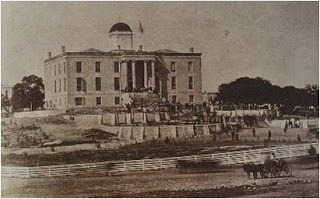
My hero, Levi Grant, enters the story after spending two years in Huntsville State Prison for an unintentional crime. Being a large, muscled man, he was put to work in the labor camps during his incarceration, breaking rock at a granite quarry. The abusive camp sergeants he faced there left him with scars inside and out, but the compassion of a prison chaplain helped him rebuild his faith and rededicate his life to serving the Lord. Upon his release, he takes up his father's blacksmithing trade and tries to create a fresh start by keeping his past a secret. Now, as the author, I couldn't allow this secret to stay hidden forever. So I began looking for ways to expose my hero's past. And I stumbled upon the perfect solution in my time period research.
In 1881, the Texas Capitol building (pictured above as it appeared in 1875) was destroyed by fire (after the fire below right). The Texas Legislature decided that when they rebuilt, they would use only materials native to the state. They initially chose limestone, as there was a quarry near Austin, but when iron particles in the rock led to discoloration, they elected red granite instead.
This granite was obtained from Granite Mountain
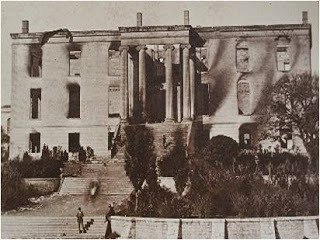 near Marble Falls, Texas in1885. To cut costs, the state contracted convict labor for breaking the stone. The use of free—or almost free—convict labor in the quarries, however, was seen as an attempt by the state to undermine unionized labor and was opposed by virtually every organized labor group in Austin. Hence, word spread throughout the region about the controversial labor force.
near Marble Falls, Texas in1885. To cut costs, the state contracted convict labor for breaking the stone. The use of free—or almost free—convict labor in the quarries, however, was seen as an attempt by the state to undermine unionized labor and was opposed by virtually every organized labor group in Austin. Hence, word spread throughout the region about the controversial labor force.This historical event allowed me to supply Levi with quarry experience during his incarceration (breaking rock at Granite Mountain), but with a project that was so well known for using convict labor, it could easily expose his past should anyone learn of his involvement. And, of course, someone does. History provided the perfect scenario. (The photo shows convicts working at Granite Mountain.)
Not only did this fabulous research gem supply the plot point I needed, but it also helped determine my setting. The story opens in 1887, in keeping with the time frame of Levi working at the labor camp in 1885 at the beginning of his incarceration, leaving time on the back end of his two-year sentence for his spiritual rehabilitation with the prison chaplain. It also played a role in the location of Spencer, Texas. Knowing how pivotal a role having a quarry nearby would be to my story, I chose to set my fictional town near Limestone County where the natural
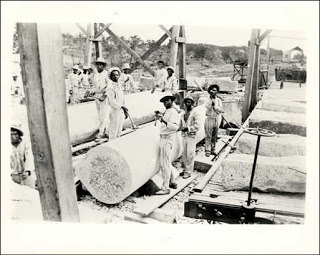 resource from which the county derived its name was abundant enough to allow me to install a quarry a few miles from town.
resource from which the county derived its name was abundant enough to allow me to install a quarry a few miles from town.Fun how things work out, isn't it?
For more information on the use of convict labor in building the Texas state capitol building, follow these links:
http://www.texfiles.com/texashistory/statecapitol.htm - Highlights the labor union dispute.
http://www.ci.austin.tx.us/library/ahc/capitol/design.htm - Great pictures of the convict labor force, Granite Mountain, and the construction of the capitol.
_____________________________________
Please join me in thanking Karen for sharing some fascinating history with us today. Believe it or not ... I'm working on a book set at the Nebraska State Penitentiary in the 1880s ... I was amazed when I learned that Karen had studied convict labor! The places we writers will go to find a story .... I declare!
Visit Karen at website: www.karenwitemeyer.com
For more about her new release: http://www.christianbook.com/to-win-her-heart/karen-witemeyer/9780764207570/pd/207571?item_code=WW&netp_id=851366&event=ESRCN&view=details
May 5, 2011
A Day at the Beach
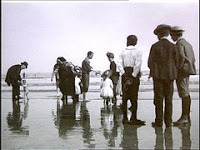 Since Newport, Rhode Island is on an island . . . there are many beaches. Back in the Gilded Age, the last few decades of the nineteenth century, two were notable—yet opposite in who frequented their sand and sea.
Since Newport, Rhode Island is on an island . . . there are many beaches. Back in the Gilded Age, the last few decades of the nineteenth century, two were notable—yet opposite in who frequented their sand and sea.
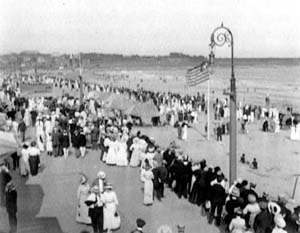 Easton's Beach and the Boardwalk
Easton's Beach and the BoardwalkFirst there was Easton's Beach, on the eastern side of Aquidneck Island, south of Easton Pond. This beach actually became too popular, as Newport grew to be not just the summer retreat of the East Coast rich, but a retreat for the working and middle class. The fact the trolleys made it easy for mill workers in nearby Fall River to go to Easton's in their free time, added to its popularity.
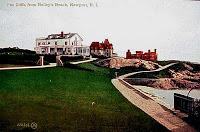 From Bailey's Beach
From Bailey's Beach But the wealthy, seeking exclusivity, left Easton's to those … other classes, and moved their patronage south to Bailey's Beach. Where Easton's could be reached by trolley, Bailey's was truly isolated, and could only be reached by foot or bicycle. The same is still true.
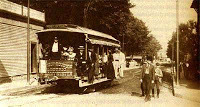
Here's a photo of a trolley in 1889. In Chapter 17 of An Unlikely Suitor, I have a young couple take the trolley to Easton's, where they wade in the ocean. For a nickel you could ride the trolley anywhere. In the early 1900's a roller coaster was added (below.)
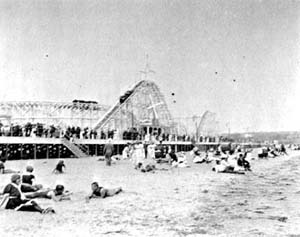 Bailey's Beach was private, with its own club house and clinentele. It's owned and run by the Spouting Rock Beach Association, and they determine its members. It's located at the south end of the Cliff Walk near Spouting Rock—which is a rock formation where the water…spouts.
Bailey's Beach was private, with its own club house and clinentele. It's owned and run by the Spouting Rock Beach Association, and they determine its members. It's located at the south end of the Cliff Walk near Spouting Rock—which is a rock formation where the water…spouts.
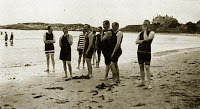 bathers on Bailey's Beach
bathers on Bailey's Beach
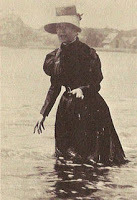
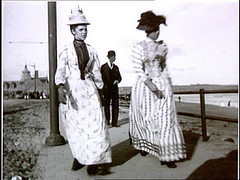
At the southeast corner of Bailey's is "Rejects Beach", a portion of the beach that is separated from Bailey's by a rope that marks its boundaries on the sand—and even into the water. Well then!
In the 1890's, the attire for swimming was ponderous. Soggy blanket anyone? And yet . . . hmm. It would have covered a multitude of body flaws. But somehow, I don't think modern day bathing beauties will go for it.//Nancy
May 1, 2011
Hats--Oh, My!

Princess Eugenie made quite a statement at the royal wedding this past week when she wore what one blogger labeled, "a doorknocker adorned with an octopus."
The Princess is only one in a very long line of women who sported noteworthy headwear. Ladies'hats have been the cause of comment and controversy for centuries.
In the 19th century, for example, hats played a role in the founding of Audubon Magazine!
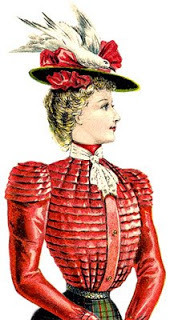 In 1886, a devoted (and ultimately outraged) birder hiked from his uptown Manhattan office to the heart of the women's fashion district on 14th Street, tallying the stuffed birds on the hats of passing women as he walked. He counted parts or entire bodies of three bluebirds, two red-headed woodpeckers, nine Baltimore orioles, five blue jays, twenty-one common terns, a saw-whet owl, and a prairie hen. In two afternoon trips he listed 174 birds from forty different species … all of them "victims of fashion." Gull, tern, heron, and egret populations were especially affected by the fashion craze involving avian accents.
In 1886, a devoted (and ultimately outraged) birder hiked from his uptown Manhattan office to the heart of the women's fashion district on 14th Street, tallying the stuffed birds on the hats of passing women as he walked. He counted parts or entire bodies of three bluebirds, two red-headed woodpeckers, nine Baltimore orioles, five blue jays, twenty-one common terns, a saw-whet owl, and a prairie hen. In two afternoon trips he listed 174 birds from forty different species … all of them "victims of fashion." Gull, tern, heron, and egret populations were especially affected by the fashion craze involving avian accents.
In 1897, Harper's Bazaar reported, "That there should be an owl or ostrich left with a single feather apiece hardly seems possible." More than birds adorned hats in the those days. Fruit, flowers, furs, and even mice and small reptiles nestled atop fashionable
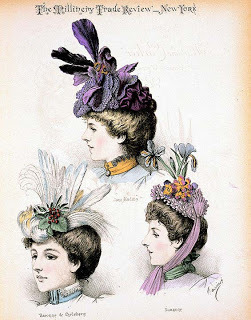 ladies' heads.Believe me ... I looked. I never did find a photo of a period hat with a "small reptile" ...
ladies' heads.Believe me ... I looked. I never did find a photo of a period hat with a "small reptile" ...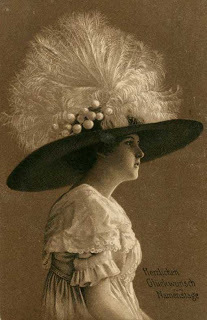
although I wonder what we'd see if we had a view of the other side of the creation on the left. Plenty of room for a menagerie. Still, I'm thinking small reptiles just didn't really catch on.
When researching Nora's Ribbon of Memories, I grew increasingly impressed with the artistry and skill required to be a successful milliner. My main character, Nora (a runaway who works in an 'establishment of ill repute' for a while as a housekeeper) eventually becomes a milliner. At one point, her new employer pulls out a "lightweight buckram frame," to use as a base for a new creation, and Nora wonders aloud, "How do you turn that thing into a hat?" The milliner goes on to show Nora how its done, "We cover the frame with … bombazine. With a black velvet bow on this side, and a black ostrich feather curving up across the top, it'll be stunning."
Another character in the book, Dr. Maude Allbright, is described as someone who "may not have been a slave to fashion ... " but was "definitely a slave to hats." Still, Dr. Allbright eschews the idea of dead birds as adornment."Every red-tailed hawk in the county will be dive-bombing me if I wear that," she scoffs, pointing to a French creation sporting three gray birds perched on the crown.
Dr. Allbright orders her hat with "posies instead of dead birds," and especially likes "a large-brimmed hat entirely camouflaged in felt-gray plumes and curled blue and yellow striped ribbon."
In the end, Nora opens her own business in fictional Millersburg, Nebraska.
One very helpful resource I discovered while working on Nora was a book called The Female Economy; the Millinery and Dressmaking Trade, 1860-1930. I close with hat history ... and some photos of imaginative head-coverings from my collection of vintage photographs. You'll notice feathers and plumes in abundance. Who knows ... maybe there's a small reptile in there somewhere.
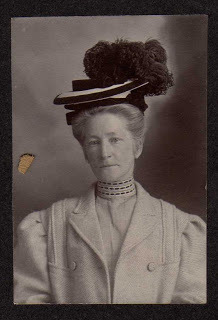 "When a girl enters a milliner's establishment, she must give three or four month's time to learning the business. After that, she receives five dollars a week; and in some instances, as she improves, her wages are increased to fifteen."
"When a girl enters a milliner's establishment, she must give three or four month's time to learning the business. After that, she receives five dollars a week; and in some instances, as she improves, her wages are increased to fifteen." "The dressmaker's assistant looks down on the factory hand … she works with 'fine things' and interacts with 'ladies' …"
"No woman wants a hat like any other hat that has ever been made."
"It is the retailer's duty to curb the extravagance of young women who cannot afford expensive hats, and thus help their customer's avoid paths that have led many girls to ruin." The Illustrated Milliner
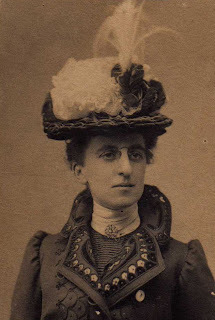
"Last evening Sallie Howe was here. We were all talking about bonnets. They all wish me to have some kind of bright flower inside my bonnet. Sarah and Lizzie wish me to have a Geranium scarlet, white strings with a scarlet edge, not to have purple by any means, they say … I wish to know what you like. I do not think pink is becoming … They say I must not have white or purple …"
"[The customer said] 'When I put my bonnet on and looked into the glass, I hardly knew myself it made me look so handsome' … disaster could have just as easily been the result … they expect us to remake them in spite of nature."
"Failure in millinery was most often caused by doing too much business on credit …etiquette prevented the tradeswoman from pressing her case."
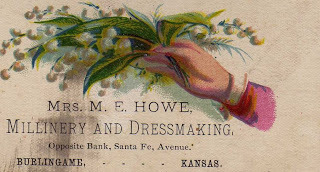
Hats still make a statement ... I do wonder what Mrs. Howe of Burlingame, Kansas, (whose business card appears above) would say about ...

 Cheers!.........................................from Stephanie
Cheers!.........................................from StephanieApril 28, 2011
My Chateau of Inspiration
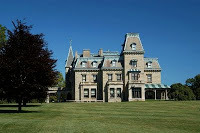 The nice thing about writing fiction is that I have some leeway to use a place that is real as inspiration, without using it per se. That's the case with the Chateau-sur-Mer in Newport, Rhode Island, the summer playground of the wealthy during the Gilded Age.
The nice thing about writing fiction is that I have some leeway to use a place that is real as inspiration, without using it per se. That's the case with the Chateau-sur-Mer in Newport, Rhode Island, the summer playground of the wealthy during the Gilded Age.When I saw this house in Newport, I fell in love. It stands on a green hill, grand but not haughty, elegant without being cold. Until the Vanderbilts started building their mega-mansions in the 1890's, it was the palatial mansion in Newport.
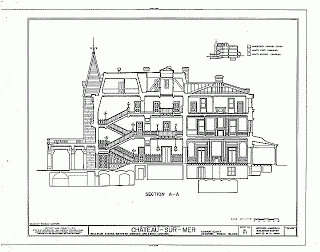 It was first built in 1852 then remodeled and added onto, twenty years later. It was built for William Shepard Wetmore who made his fortune in the China trade. Originally it encompassed 35 acres and had a sea-view. But later, some of its land was sold (and the Breakers built upon it), making this "castle on the sea" landlocked. William and his wife once had a party for 3000 in the house!
It was first built in 1852 then remodeled and added onto, twenty years later. It was built for William Shepard Wetmore who made his fortune in the China trade. Originally it encompassed 35 acres and had a sea-view. But later, some of its land was sold (and the Breakers built upon it), making this "castle on the sea" landlocked. William and his wife once had a party for 3000 in the house!When William died in 1862, the house passed to his son, George, who eventually became the governor of Rhode Island (1885-1887), and a state senator (1894-1912.) He hired Richard Morris Hunt to transform the house—which Hunt did, starting in 1871. He changed it so much that many people thought the original house had been torn down. Hunt later was the architect on the Vanderbilt's Breakers and Marble House.
I include Mr. and Mrs. Wetmore at a dinner party in Chapter 13 of my book. A little ironic twist that they are guests in the fictitious Langdon mansion inspired by their very real home.
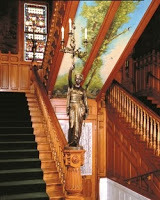 There are five areas of Chateau-sur-Mer that I used in An Unlikely Suitor. I am very partial to wood trim (you would know that if you saw my house), so the paneling of the grand entry really spoke to me. Plus, the stained glass and skylight are stunning. I had great fun writing a scene where my immigrant seamstress character, Lucy, first walks into the house.
There are five areas of Chateau-sur-Mer that I used in An Unlikely Suitor. I am very partial to wood trim (you would know that if you saw my house), so the paneling of the grand entry really spoke to me. Plus, the stained glass and skylight are stunning. I had great fun writing a scene where my immigrant seamstress character, Lucy, first walks into the house.
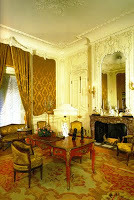
The second room I used was the French parlor—that I called Mrs. Langdon's morning room. It's notable because the wood paneling of the rest of the house is present there too, but Edith Wetmore had it painted white. As a lover of wood and its grain I cringed. But it's a very feminine room in a very masculine house.
Third, was the Butternut Bedroom. I made this the bedroom belonging to my main character, Rowena. She's very warm and unassuming, and I felt the color of the butternut wood suited her, and was a contrast to the formal, assuming, white morning room preferred by her mother.
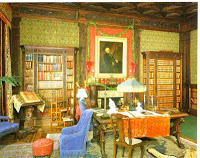
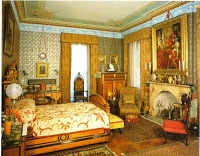 The Library was another room that inspired a scene, a confrontation between a poor girl in want of a book to read, the heir, and a butler. I have a library in my house, with lots of wood and shelves, so I love this type of room.
The Library was another room that inspired a scene, a confrontation between a poor girl in want of a book to read, the heir, and a butler. I have a library in my house, with lots of wood and shelves, so I love this type of room.Lastly, the back of the Chateau had a porch facing the sea. I created a scene that had Rowena painting a landscape on the porch, and it was also a place she could go to contemplate the drama in the book. (Note: these wonderful interior photos are from a great book about the mansions of Newport by the Preservation Society of Newport County: I added a room-sized dressing room for Rowena, and stables and outbuildings, as needed. But the spirit of the Chateau lives on in my fictional Porte au Ciel: Gate to Heaven.
When I visited Newport in 2005, the Chateau-sur-Mer was undergoing a restoration but is now open to the public. It's on my to-do list. After all, the house and I have become very close.//Nancy
April 25, 2011
How to Help a Grieving Friend ... personal history
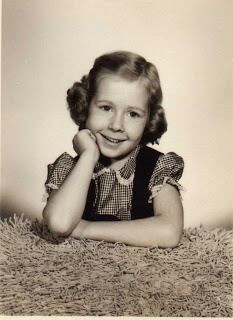 I (as in Stephanie, pictured on the right before she was published) hope you won't mind indulging me on this Monday-after-Easter with a brief announcement and a few reflections on some personal history, since the promise of Easter is very personal.
I (as in Stephanie, pictured on the right before she was published) hope you won't mind indulging me on this Monday-after-Easter with a brief announcement and a few reflections on some personal history, since the promise of Easter is very personal.The older I get, the more I look forward to Heaven, because the list of people I get to see again grows. I particularly think about my first husband, Bob, and my own parents. Bob's parents are there, too, and this past year my grandson Barrett left for heaven before I held him in my arms as a newborn.
This past Easter Sunday, I copied parts of 1 Corinthians ... "If Christ has not been raised ... your faith is worthless; If Christ has not been raised ... you are still in your sins ... and those who have fallen asleep have perished ... BUT Christ has been raised! ... (and someday), "in a moment ... in the twinkling of an eye ... the dead will be raised imperishable ... and death will be swallowed up in victory." I believe that with all my heart. And yet ... in the meantime ... part of being human is facing hurt and loss.
I learned a lot about grief between 1996 and 2001. In 1996, just a few days after Bob received his "terminal" cancer diagnosis, my best friend died of breast cancer. A few months later, both my parents died within six months of each other. And then, in 2001, Bob graduated to heaven.
It wasn't until after Bob had left this earth that I began to realize how terrible I was at helping grieving friends. I found myself calling them and apologizing for stupid things I'd said or done ... things that, at the time, I intended to be helpful. Things that, now that I was the one facing loss, I suddenly realized weren't helpful at all. In fact, some of my well-intentioned words were hurtful. I joked with another widow about writing a book called Lifestyles of the Well Meaning but Clueless ... because I realized how clueless I had so often been.
Thus was borne How to Help a Grieving Friend, a little book that talks about "how it feels" to grieve and then focuses on "how to help," giving practical ways to offer meaningful help in times of loss.
Not surprisingly, it took my agent a long timeto find it a home. Why? "Well," publishers said, "we just don't do death and dying well." Which, my agent said, was exactly the point. Isn't it interesting that the one thing that every single person ever born has in their personal history, is also the thing that "we don't do well."
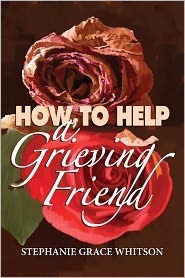 And so my announcement:
And so my announcement:
How to Help a Grieving Friend, is
now available in ebook format for Kindle (http://www.amazon.com/How-Help-Grieving-Friend-ebook/dp/B004WBJ6C6/ref=sr_1_1?ie=UTF8&m=AG56TWVU5XWC2&s=digital-text&qid=1303768778&sr=1-1) and Nook (http://search.barnesandnoble.com/How-to-Help-a-Grieving-Friend/Stephanie-Grace-Whitson/e/2940012328199/?itm=1&USRI=how+to+help+a+grieving+friend and will soon be available as a print book. (I don't own an ebook reader, by the way ... but I downloaded Nook's free app onto my PC and voila ... I can order ebooks!)
If you feel as awkward and helpless as I used to when headed to a funeral (or when I saw someone in the grocery store who had just lost a loved one), if you've wondered what to say or do, this little book can help.
Today's "personal history" blog closes with a poem I wrote many years ago as a reminder of the promise we celebrate at Easter. I hope it encourages you. Because He lives ....Stephanie
Cocoons

A lifeless shell (to earthly eyes) can open,
freeing its surprise to dance on a garden leaf.
Gossamer wings gently hesitate to fly.
And then, as wind abates, it flutters towards the sky.
Out of sight, it yet exists and, dancing on, its wings persist to unseen garden leaves.
No less alive, though out of sight, it testifies to each man's plight;
a common destiny.
For each of us must leave behind a lifeless shell.
and earthly-minded men can think, "Life's done."
 It isn't true.
It isn't true.Although unseen, we flutter on to gardens green with joy,
alive in Christ.Alive in Christ, Who's dead cocoon, though buried in a garden tomb arose to give new life.
Here's hope for all in facing death: a lifeless shell (to earthly eyes)
precedes the birth of butterflies.
April 21, 2011
A New Book and a Contest!
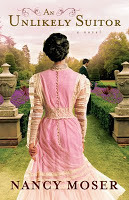 It's always exciting to hold a new book in my hands, and my newest has finally arrived! An Unlikely Suitor is set in the Gilded Age, 1895. A New York seamstress, along with her sister and mother, help create a summer wardrobe for a rich heiress. They end up in the summer haven of the rich, Newport, Rhode Island. A friendship ensues, a bit of danger, and a lot of romance.
It's always exciting to hold a new book in my hands, and my newest has finally arrived! An Unlikely Suitor is set in the Gilded Age, 1895. A New York seamstress, along with her sister and mother, help create a summer wardrobe for a rich heiress. They end up in the summer haven of the rich, Newport, Rhode Island. A friendship ensues, a bit of danger, and a lot of romance.
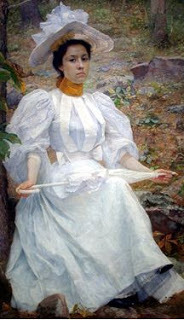 I've talked about the book in earlier posts, and have begun sharing some of the insights into Newport and the sewing process that I discovered while doing the research. I'll share more in future weeks. Here's a woman who looks like Lucia Scarpelli, my seamstress... I love finding portraits of people who match the characters in my head. The fact she'd dressed ala 1895, and is sitting in a place that looks like Newport's Cliff Walk. Zounds, I couldn't have imagined her any better!
I've talked about the book in earlier posts, and have begun sharing some of the insights into Newport and the sewing process that I discovered while doing the research. I'll share more in future weeks. Here's a woman who looks like Lucia Scarpelli, my seamstress... I love finding portraits of people who match the characters in my head. The fact she'd dressed ala 1895, and is sitting in a place that looks like Newport's Cliff Walk. Zounds, I couldn't have imagined her any better!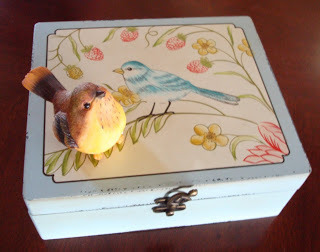 I'm so excited about the book's release that I'm having a contest. I'm giving away a vintage-inspired wooden box full of goodies (worth over $50), an antique piece of jewelry (that sparkles), and a copy of the novel. Three winners. All you have to do is leave a comment to this blog entry and tell me the era of history you most like to read about. Who knows? Maybe I'll choose that time in history as a setting in a future novel. Or you can also enter on my website at www.nancymoser.com or on my Facebook page. I'll draw the three winners on May 15.
I'm so excited about the book's release that I'm having a contest. I'm giving away a vintage-inspired wooden box full of goodies (worth over $50), an antique piece of jewelry (that sparkles), and a copy of the novel. Three winners. All you have to do is leave a comment to this blog entry and tell me the era of history you most like to read about. Who knows? Maybe I'll choose that time in history as a setting in a future novel. Or you can also enter on my website at www.nancymoser.com or on my Facebook page. I'll draw the three winners on May 15.Also, just a note... if you like the book I'd sure appreciate you spreading the word, and leaving a review on one of the online bookstores like Christianbook.com, Amazon.com, or barnesandnoble.com. If you don't like the book, shhh! Just kidding. You're welcome to give your true opinion.
Thank you ever so much for your readership! Without you, I'm writing to the wind.//Nancy
April 16, 2011
Where Did They Get Their Simplicity Patterns?

<?xml:namespace prefix = o />
In the U.S., until Butterick began to publish patterns, fashionable clothing that fit properly was the purview of the wealthy. The rest of society either wore makeshift clothing that didn't fit very well or hoped for hand-me-downs from someone higher up the income ladder. Aprons (a straight piece of cloth gathered onto a narrow piece of cloth tied at the waist) or belts often give shape to what was little more than a long, hemmed, sack. In this engraving of a maid in the 1750s, the softness around her neck is probably a square of cloth folded and draped like a scarf. The headgear? A circle (invert a pail, a basket, or a crock and you've got a circle pattern) gathered to fit around the head (measure with a length of twine to see how far to draw it up). I'm no seamstress, but I think I could manage.
Of course none of that was sufficient for women who were part of the growing "middle class" 19th century America. By then, a woman's dress required buttonholes and darts and set-in sleeves. Enter (I think) the women like Mom Pennell who had the gift to look at the page and make it happen.
While the Civil War created demand for men's ready-to-wear in the form of army uniforms, women would have to wait until later in the century (the 1880s) for much to happen in that marketplace (and then, of course, they'd still need the means to barter or buy). I know from reading western women's pioneer diaries that they helped each other with their sewing needs. So I'm going to make an "educated supposition" that, if there was a Mom Pennell within twenty miles, she probably helped more than one pioneer woman with her dressmaking. (It's also possible to de-construct a dress you like and use it for a pattern. Seam-ripper in hand, a pioneer woman could have taken a dress apart and used the resulting pieces as a pattern for years to come. Did they? I haven't a clue … but I once did that with a beloved dress.) The brief research I've done on the history of dressmaking indicates that Godey's Lady's Book offered full-size patterns in the 1850s. When I learned that, I rushed to my bookshelf to check my 1875 Godey's. Alas, no dress patterns that year, although pull-out fashion plates abound.
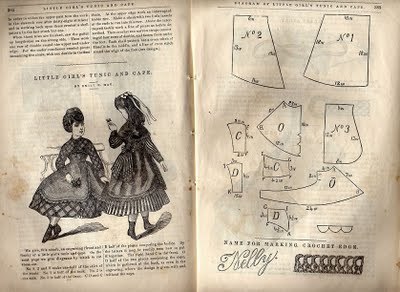
I did, however, find the pattern on the left in an 1869 edition of Peterson's Magazine. How long do you suppose it took a woman to transfer the drawings into usable size ... and how did she make this "one-size-fits-all" approach work for her child? The brief instructions include the admonition that, "by the letters it may be readily seen how to put it together." Oh ... really????
Mass-produced, sized, dress patterns came along thanks to Ebenezer Butterick. The family cut and folded the patterns by hand at first, moving into mass production by 1866. Millions had been sold by 1871. James McCall became a competitor. I enjoyed reading the Butterick company history here: http://butterick.mccall.com/butterick-history-pages-1007.phpphp.
Thanks to Vince for suggesting this topic. (Simplicity, by the way, was founded in 1927 ... I didn't know that!)
I, for one, have new appreciation for how easily I can don an "Easter outfit" if I so choose...although I am far more interested this year in snuggling my Easter grand-babies than thinking about new clothes! Here's the First Arrival with his big sister ... hours after his April 14 arrival. The next Easter baby is due any day now ... she and her cousin will be in the same church nursery soon.




